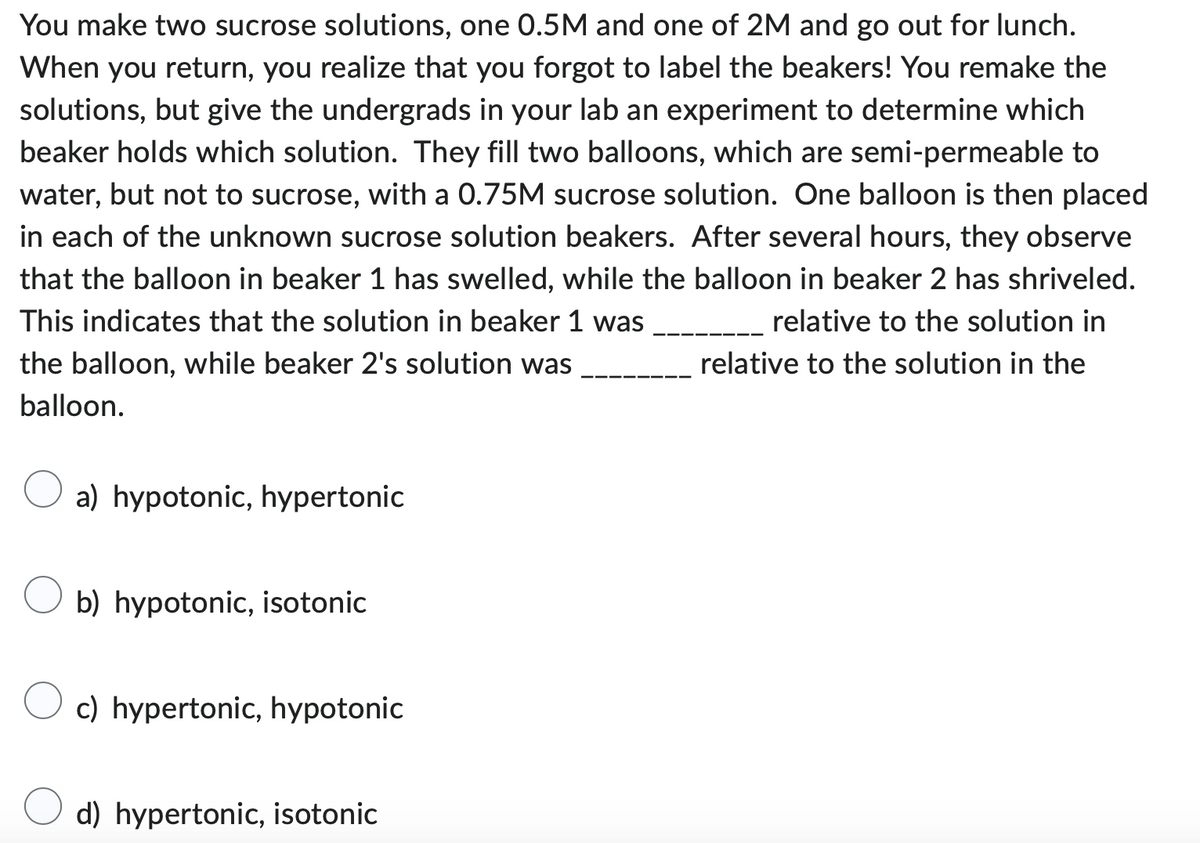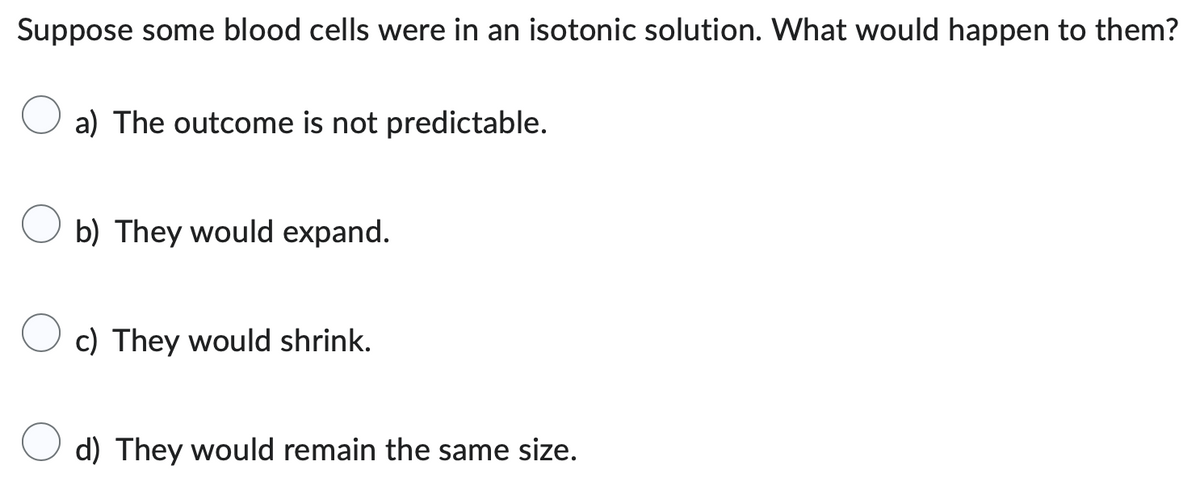You make two sucrose solutions, one 0.5M and one of 2M and go out for lunch. When you return, you realize that you forgot to label the beakers! You remake the solutions, but give the undergrads in your lab an experiment to determine which beaker holds which solution. They fill two balloons, which are semi-permeable to water, but not to sucrose, with a 0.75M sucrose solution. One balloon is then placed in each of the unknown sucrose solution beakers. After several hours, they observe that the balloon in beaker 1 has swelled, while the balloon in beaker 2 has shriveled. This indicates that the solution in beaker 1 was the balloon, while beaker 2's solution was balloon. relative to the solution in relative to the solution in the a) hypotonic, hypertonic b) hypotonic, isotonic c) hypertonic, hypotonic d) hypertonic, isotonic
You make two sucrose solutions, one 0.5M and one of 2M and go out for lunch. When you return, you realize that you forgot to label the beakers! You remake the solutions, but give the undergrads in your lab an experiment to determine which beaker holds which solution. They fill two balloons, which are semi-permeable to water, but not to sucrose, with a 0.75M sucrose solution. One balloon is then placed in each of the unknown sucrose solution beakers. After several hours, they observe that the balloon in beaker 1 has swelled, while the balloon in beaker 2 has shriveled. This indicates that the solution in beaker 1 was the balloon, while beaker 2's solution was balloon. relative to the solution in relative to the solution in the a) hypotonic, hypertonic b) hypotonic, isotonic c) hypertonic, hypotonic d) hypertonic, isotonic
Chemistry for Today: General, Organic, and Biochemistry
9th Edition
ISBN:9781305960060
Author:Spencer L. Seager, Michael R. Slabaugh, Maren S. Hansen
Publisher:Spencer L. Seager, Michael R. Slabaugh, Maren S. Hansen
Chapter7: Sollutions And Colloids
Section: Chapter Questions
Problem 7.117E
Related questions
Question
20, 21

Transcribed Image Text:You make two sucrose solutions, one 0.5M and one of 2M and go out for lunch.
When you return, you realize that you forgot to label the beakers! You remake the
solutions, but give the undergrads in your lab an experiment to determine which
beaker holds which solution. They fill two balloons, which are semi-permeable to
water, but not to sucrose, with a 0.75M sucrose solution. One balloon is then placed
in each of the unknown sucrose solution beakers. After several hours, they observe
that the balloon in beaker 1 has swelled, while the balloon in beaker 2 has shriveled.
This indicates that the solution in beaker 1 was
the balloon, while beaker 2's solution was
balloon.
relative to the solution in
relative to the solution in the
a) hypotonic, hypertonic
b) hypotonic, isotonic
c) hypertonic, hypotonic
d) hypertonic, isotonic

Transcribed Image Text:Suppose some blood cells were in an isotonic solution. What would happen to them?
a) The outcome is not predictable.
b) They would expand.
c) They would shrink.
d) They would remain the same size.
Expert Solution
This question has been solved!
Explore an expertly crafted, step-by-step solution for a thorough understanding of key concepts.
Step by step
Solved in 5 steps

Knowledge Booster
Learn more about
Need a deep-dive on the concept behind this application? Look no further. Learn more about this topic, chemistry and related others by exploring similar questions and additional content below.Recommended textbooks for you

Chemistry for Today: General, Organic, and Bioche…
Chemistry
ISBN:
9781305960060
Author:
Spencer L. Seager, Michael R. Slabaugh, Maren S. Hansen
Publisher:
Cengage Learning

Chemistry: Matter and Change
Chemistry
ISBN:
9780078746376
Author:
Dinah Zike, Laurel Dingrando, Nicholas Hainen, Cheryl Wistrom
Publisher:
Glencoe/McGraw-Hill School Pub Co


Chemistry for Today: General, Organic, and Bioche…
Chemistry
ISBN:
9781305960060
Author:
Spencer L. Seager, Michael R. Slabaugh, Maren S. Hansen
Publisher:
Cengage Learning

Chemistry: Matter and Change
Chemistry
ISBN:
9780078746376
Author:
Dinah Zike, Laurel Dingrando, Nicholas Hainen, Cheryl Wistrom
Publisher:
Glencoe/McGraw-Hill School Pub Co


Introductory Chemistry: An Active Learning Approa…
Chemistry
ISBN:
9781305079250
Author:
Mark S. Cracolice, Ed Peters
Publisher:
Cengage Learning

Introductory Chemistry: A Foundation
Chemistry
ISBN:
9781337399425
Author:
Steven S. Zumdahl, Donald J. DeCoste
Publisher:
Cengage Learning

Chemistry: The Molecular Science
Chemistry
ISBN:
9781285199047
Author:
John W. Moore, Conrad L. Stanitski
Publisher:
Cengage Learning